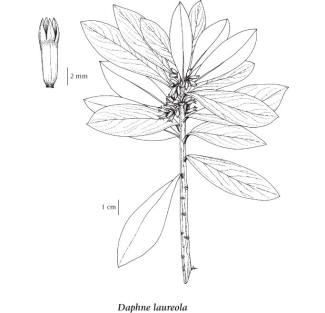Daphne laureola L.
spurge-laurel (spurgelaurel)
Thymelaeaceae (Mezereum family)
Introduction to Vascular Plants
spurge-laurel (spurgelaurel)
Thymelaeaceae (Mezereum family)
Introduction to Vascular Plants
Introduction
Spurge-laurel (Daphne laureola) is an invasive and noxious weed in BC. It is an introduced shrub that is found in Europe, southwestern Asia, north Africa and the Mediterranean region in oak and conifer woods ( Nevling and Barringer 2018). It has escaped from gardens in the Pacific Northwest and is now found throughout the southwest corner of the province. It easily spreads in gardens and in regional forests. The bark, sap and berries are toxic to humans: the sap is very irritating to the skin. This species is listed by the Canadian Poisonous Plants Information System, WorkSafe BC Toxic Plant Warning and the Invasive Plant Council of BC. The BC Ministry of Forests, Lands and Natural Resource Operations lists this species as a reportable weed in BC via their Report a Weed program.
Note author: Rose Klinkenberg |
Species Information
General:
Evergreen shrub, bushy, 0.5-1.8 m tall.
Leaves:
Alternate, oval to oblanceolate, tapering towards the base, dark green, somewhat glossy, 4-13 cm long.
Flowers:
Inflorescence of axillary, nearly unstalked clusters; corollas lacking; calyces pale green, with 4 cylindrical, spreading lobes.
Fruits:
Drupes, egg-shaped, black, 8-11 mm long.
Illustration

If more than one illustration is available for a species (e.g., separate illustrations were provided for two subspecies) then links to the separate images will be provided below. Note that individual subspecies or varietal illustrations are not always available.
Illustration Source: The Illustrated Flora of British Columbia
Ecology
Ecological Framework for Daphne laureola
The table below shows the species-specific information calculated from
original data (BEC database) provided by the BC Ministry of Forests and Range.
(Updated August, 2013)
The table below shows the species-specific information calculated from
original data (BEC database) provided by the BC Ministry of Forests and Range.
(Updated August, 2013)
| Site Information |
Value / Class |
||
|
Avg |
Min |
Max |
|
| Elevation
(metres) |
107 | 50 | 192 |
| Slope
Gradient (%) |
6 | 0 | 15 |
|
Aspect (degrees) |
155 | 134 | 200 |
| Soil
Moisture Regime (SMR) [0 - very xeric; 4 - mesic; 8 - hydric] |
3 | 1 | 5 |
| Modal
Nutrient Regime
Class |
D | ||
| #
of field plots species was recorded in: |
6 | ||
| Modal
BEC Zone Class |
CDF | ||
|
All BEC Zones (# of stations/zone) species was recorded in |
CDF(6) | ||
|
Source:
Klinkenberg 2013
|
|||
Habitat and Range
Mesic forests and waste areas in the lowland zone; infrequent on S Vancouver Island, the Gulf Islands and adjacent mainland; introduced from Eurasia.Status Information
Taxonomic Notes
This species is listed by the Greater Vancouver Invasive Plant Council of the twelve most problematic species in the Vancouver region. For further information about control of this species, visit their web site.
|